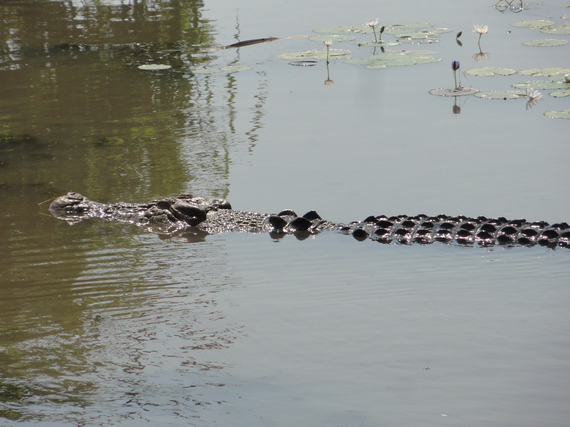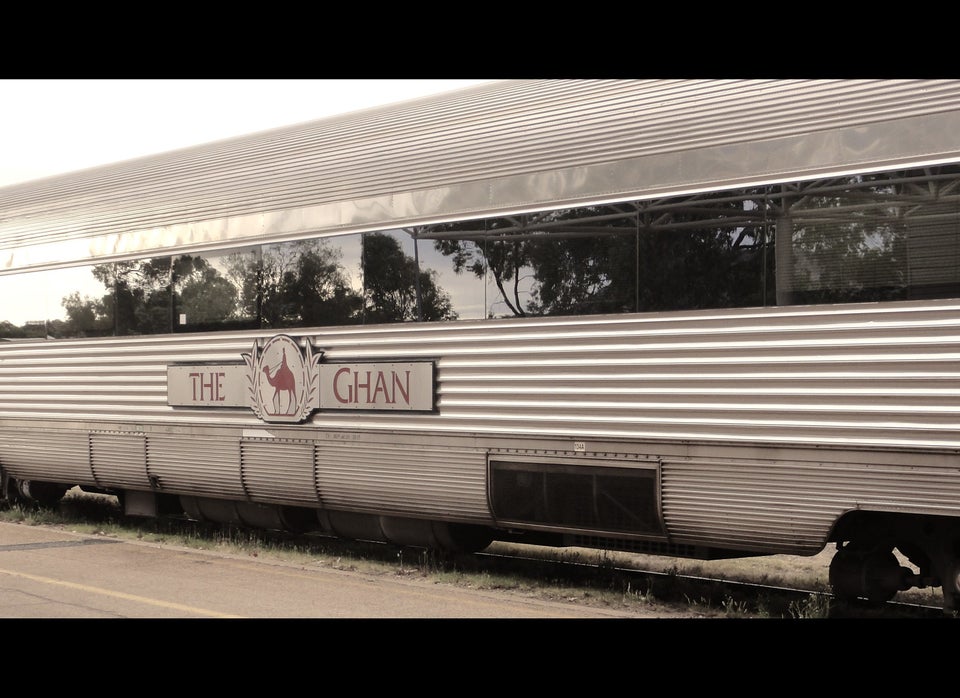My recent trip to the Northern Territory of Australia was one of the best I've taken - dramatic landscapes, red earth, interesting outposts, luxury trains, and crocodiles - really big crocodiles!
Australia is huge and it was my desire not to fly over it but to experience as much of the land as possible. Maybe that's because most of my work life with an airline required me to fly, and I always felt as if I was missing the really good parts of a country by only seeing it from the air. Or, maybe it's because I have "a thing" for flowers, dirt, and critters.
When the chance came to see Australia by train I jumped at it. My final destination was Kakadu National Park (a two-hour drive from Darwin). And the opportunity to see ancient rock art and exotic plants and to experience first-hand the large Australian crocodiles ("salties"), was exciting.
I boarded the Ghan Train in Alice Springs, and traveled in a Gold class cabin, which was spacious and had its own shower and toilet - extremely comfortable. The food was really good, and the staff friendly, and informative. The highlight of the train journey for me was the ability to look out the window at any time and see the beauty of red dirt as far as the horizon, with little dots of green shrubs here and there. Mind you, I had no plans to get off and wander around as the Australian deserts are full of snakes and spiders, and this country has the most deadly of both in the world. The land is hot, desolate and treacherous if on foot, thus the train ride.
We arrived in Darwin after a 24-hour ride and the next day set off for Kakadu National Park (a UNESCO human heritage and natural site). We stopped at one of the local outposts for water, coffee and other local treats, and while there observed a group of local Aborigines purchasing items. Quiet, and focused on what they were doing, they never said hello or appeared to notice us. I'd observed this same behavior in Alice Springs. Some of the people in our group were African Americans and made an effort to converse with them. I believe, that some of the Americans thought that they could communicate with the Aborigines because of similar skin color. It didn't work, the locals never acknowledged them. I was curious about this and wondered who felt insulted more.
Our guide told us that we would be traveling on boats through the Alligator River branches - the South and the East. There are actually three branches of rivers - North, East and South - named in 1820 by an English explorer, Lieutenant Phillip Parker King, who saw crocodiles and assumed they were alligators. These are really big crocodiles and the name was given to them because they are known to swim and live in the ocean as well as the rivers. This makes them very dangerous because of their size, intelligence, and ferocity - they're not afraid of anything!!!
Our guide for the trip down the East Alligator River described what we were seeing as we floated along the river. Picture a semi-tropical area with several varieties of trees, a wide river filled with huge flowering water lily pads and other tropical-like plants. Native ducks and many other bird families all swooping and diving and nesting along the river. Much of the land had stands of the native Australian Gum tree and even clumps of tall, green bamboo. We learned that there was an active effort by national park rangers and local people to ensure original flora and fauna remained and thrived. For this reason, animals from the 19th and 20th centuries who were imported to aid in agricultural production and escaped to the wild - water buffalo, feral house cats, camels, pigs, and horses who roam throughout the park, were culled. This also was the case for plants that weren't native to the area. The park rangers continue to be diligent in working to reduce the affect these interlopers have on the original habitat.
Our first real river adventure with an Aboriginal guide was on the South Alligator River. Meeting us was Nigel, who calmly and carefully explained the do's and don'ts for the excursion. He was from the local Arnhem Aboriginal clan that had lived in the area for at least 50,000 years. Most importantly he said, this was not a theme park ride, this was real - and the large crocs meant business - they would eat us if they had a chance. So, leaning over to get "that great picture" may not be a good idea. Nigel repeated his instructions so there was no misunderstanding as to what was expected of us.
We had seen many Aboriginal people in the parks and on the streets of Alice Springs, Uluru and Darwin but this was going to be our first up-close-and-personal interaction.
My first impression of Nigel as we pushed away from the pier was of a quiet, dignified man who demanded respect without opening his mouth. As an African-American I was especially intrigued by his physical appearance - very dark brown skin and hair that was thick with very black curls! There's a theory that the first inhabitants may have come from Timor or Indonesia when the sea between the two landmasses was rather shallow. That may account for the origins of his physical appearance.
Nigel said he was a member of the Yoiungu clan and a caretaker of Arnhem Land - Aboriginal land re-given to them in 1931. He told us the name was given to the land when a captain from the Dutch East Indies Company sailed into the Gulf of Carpentaria in 1623, saw the land, and named it after his ship, and that is the name of a city in Holland.
As we glided along the river we started seeing croc heads poking out of the river. With real crocs so close, it was exciting. In a ten-minute period we saw at least 50 crocs. Nigel said most were considered small, but to us they seemed huge. They watched us and we watched them. At times Nigel would turn off the boat's engine and we would float down the middle of the river or near the river banks. A little scary considering there were so many crocs and the boat didn't have high sides. If a croc decided we were going to be dinner we would have been easy pickings. I have been on several African safaris and ridden in open safari vehicles. Knowing the drill, I kept still and didn't make any big moves.
At one point Nigel took us to a small sandy beach and invited us to step on his homeland. This was an honor because we had been told that it was up to the guide to allow us to do this.
As we stood looking over the river, Nigel told us two sad and disturbing stories. First, the place where we were standing had been invaded by a large croc several months ago. He said that crocs are really intelligent and opportunistic hunters, and notice everything. He recalled that on several days when he brought tours to this spot he spied an especially large croc lurking on the other side of the river. It seemed the croc knew the times of the tours - 11:00 a.m. and 2:00 p.m., and would appear. A few weeks later after he was visiting this very spot, without a tour, and as he was walking towards the river to get on his boat, he saw this same huge croc hiding behind a tree near the path! Nigel jumped up on a large rock, took a picture of the croc and waited until he left. From then on he and the other guides looked out for this croc and told tourists, NOT to wander off from their group.
And finally he shared a very sad story about his 12-year old nephew who was playing by the river with friends about six months ago, and was attacked by a large croc that killed him. Nigel told us it was a very sad time for his community.
Even with training and experience around these large predators, you are never safe and have to be ever vigilant. We were all so sad to hear this and wished him our best.
Our trip to Kakadu National Park and the Alligator Rivers was memorable in spite of the sadness we felt for Nigel. We learned so much about his people, culture and the importance of the land. If you plan a visit to Australia, please make it a point to visit Kakadu and the Northern Territory. Sydney, Cairns, the Great Barrier Reef are all stunning, but the Northern Territory has so much more to offer in terms of understanding the Aboriginal people - the group with the longest continuous history and language of any people on the planet. I thank Nigel for his generosity in sharing his people and dreams. I thank Australia for inviting us to see the Northern Territory; it was well worth the trip.
Granny Regina Fraser
Keeping an eye out for "salties"... I know they're not in the U.S. but you never know!!

